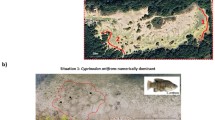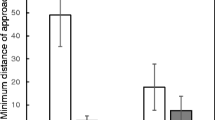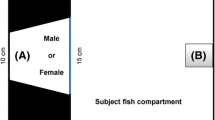Synopsis
A field study was undertaken to describe the territorial behaviour of male johnny darters (Etheostoma nigrum) over the reproductive cycle. While defending eggs, males performed fewer Lateral Displays and lost fewer encounters with conspecific males than in the pre-egg phase. As the reproductive cycle progressed males were less responsive to females and performed relatively fewer courtship and more aggressive displays. Nesting males apparently shifted from a sexual to a parental phase shortly after acquiring eggs.
Frequency of response, responsiveness (number of responses/number of intrusions x 100) and maximum distance of response (MDR) of male johnny darters were highest early in the reproductive cycle and decreased over the egg-guarding phase. The patterns of territorial defence exhibited by male johnny darters over the reproductive cycle were similar to those of other species of fish with paternal care.
Similar content being viewed by others
References cited
Assem, J. van den. 1967. Territory in the three-spined sticklebackGasterosteus aculeatus L. Behaviour Suppl. 16: 1–164.
Atz, J.W. 1940. Reproductive behavior in the eastern johnny darter,Boleosoma nigrum olmstedi (Storer). Copeia 1940: 100–106.
Black, R. 1971. Hatching success in the three-spined stickleback (Gasterosteus aculeatus) in relation to changes in behavior during the parental phase. Anim. Behav. 19: 532–541.
Bol, A.C.A. 1959. A consummatory situation: The effect of eggs on the sexual behavior of the male three-spined stickleback (Gasterosteus aculeatus L.). Experientia 15: 115–116.
Colgan, P.W. & M.R. Gross. 1977. Dynamics of aggression in male pumpkinseed sunfish (Lepomis gibbosus) over the reproductive phase. Z. Tierpsychol. 43: 139–151.
Colgan, P.W., W.A. Nowell, M.R. Gross & J.W.A. Grant. 1979. Aggressive habituation and rim circling in the social organization of bluegill sunfish (Lepomis macrochirus). Env. Biol. Fish. 4: 29–36.
Colgan, P.W., W.A. Nowell & N.W. Stokes. 1981. Spatial aspects of nest defence by pumpkinseed sunfish (Lepomis gibbosus): stimulus features and an application of catastrophe theory. Anim. Behav. 29: 433–442.
Constantz, G.D. 1979. Social dynamics and parental care in the tessellated darter (Pisces: Percidae). Acad. Nat. Sci. Phila. Proc. 131: 131–138.
Crocker, D.W. & D.W. Barr. 1968. Handbook of the crayfishes of Ontario. University of Toronto Press, Toronto. 158 pp.
Dawkins, R. & J.R. Krebs. 1978. Animal signals: information or manipulation? pp. 282–309.In: J.R. Krebs & N.B. Davies (ed.) Behavioural Ecology, An Evolutionary Approach, Blackwell, Oxford.
Downhower, J.F. & L. Brown. 1980. Mate preferences of female mottled sculpins,Cottus bairdi. Anim. Behav. 28: 728–734.
Downhower, J.F. & R. Yost. 1977. The significance of male parental care in the mottled sculpin (Cottus bairdi). Amer. Zool. 17: 936 (Abstract).
Grant, J.W.A. 1980. Territoriality, reproductive success, and mate choice in the johnny darter (Etheostoma nigrum Rafinesque). M.Sc. Thesis, Queen's University, Kingston. 92 pp.
Grant, J.W.A. & P.W. Colgan. 1983. Reproductive success and mate choice in the johnny darter,Etheostoma nigrum (Pisces: Percidae). Can. .I. Zool. (in press).
Gross, M.R. & A.M. Macmillan. 1981. Predation and the evolution of colonial nesting in bluegill sunfish (Lepomis macrochirus). Beh. Ecol. Sociobiol. 8: 163–174.
Huntingford, F.A. 1977. Inter- and intraspecific aggression in male sticklebacks. Copeia 1977: 158–159.
Iersel, J.J.A. van. 1953. An analysis of the parental behaviour of the male three-spined stickleback (Gasterosteus aculeatus L.). Behaviour Suppl. 3: 1–159.
Keenleyside, M.H.A. 1972. Intraspecific intrusions into nests of spawning longear sunfish (Pisces: Centrarchidae). Copeia 1972: 272–278.
Keenleyside, M.H.A. 1979. Diversity and adaptation in fish behaviour. Springer-Verlag, Berlin. 208 pp.
Keenleyside, M.H.A. & F.T. Yamamoto. 1962. Territorial behaviour of juvenile Atlantic salmon (Salmo salar L.). Behaviour 19: 138–169.
Kramer, D.L. 1973. Parental behaviour in the blue gouramiTrichogaster trichopterus (Pisces: Belontiidae) and its induction during exposure to varying numbers of conspecific eggs. Behaviour 47: 14–32.
Manning, A. 1972. An introduction to animal behaviour. MacMillan, Toronto. 294 pp.
Maynard Smith, J. & G.A. Parker. 1976. The logic of asymmetric contests. Anim. Behav. 24: 159–175.
McInerney, J.E. 1969. Reproductive behaviour of the blackspotted stickleback,Gasterosteus wheatlandi. J. Fish. Res. Board Can. 26: 2061–2075.
McKenzie, J.A. 1969. A descriptive analysis of the aggressive behaviour of the male brook stickleback,Culaea inconstans. Can. J. Zool. 47: 1275–1279.
Morris, D. 1958. The reproductive behaviour of the ten-spined stickleback (Pygosteus pungifus L.). Behaviour Suppl. 6: 1–154.
Perrone, M. Jr. 1978. The economy of brood defence by parental cichlid fishes,Cichlasoma maculicauda. Oikos 31: 137–141.
Phillips, R.R. 1971. The relationship between social behavior and the use of space in the benthic fishChasmodes bosquianus Lacepede (Teleostei: Blenniidae). II. The effect of prior residency on social and enclosure behavior. Z. Tierpsychol. 29: 389–408.
Ross, M.R. 1977. Aggression as a social mechanism in the creek chub (Semotilus atromaculatus). Copeia 1977: 393–397.
Rowland, W.J. 1974. Reproductive behavior of the fourspine stickleback,Apeltes quadracus. Copeia 1974: 183–194.
Sokal, R.R. & F.J. Rohlf 1969. Biometry. W.H. Freeman, San Francisco. 776 pp.
Winn, H.E. 1958a. Comparative reproductive behavior and ecology of fourteen species of darters (Pisces: Percidae). Ecol. Monogr. 28: 155–191.
Winn, H.E. 1958b. Observations on the reproductive habits of darters (Pisces: Percidae). Amer. Midl. Nat. 59: 190–212.
Wirtz, P. 1978. The behaviour of the MediterraneanTripterygion species (Pisces: Blennioidei). Z. Tierpsychol. 48: 142–174.
Wootton, R.J. 1971. Measures of the aggression of parental three-spined sticklebacks. Behaviour 40: 228–262.
Author information
Authors and Affiliations
Rights and permissions
About this article
Cite this article
Grant, J.W.A., Colgan, P.W. Territorial behaviour of the male johnny darter,Etheostoma nigrum . Environ Biol Fish 10, 261–269 (1984). https://doi.org/10.1007/BF00001479
Received:
Accepted:
Issue Date:
DOI: https://doi.org/10.1007/BF00001479




